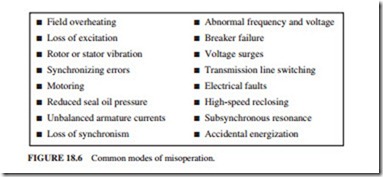 GENERATOR ROTOR RELIABILITY AND LIFE EXPECTANCY
GENERATOR ROTOR RELIABILITY AND LIFE EXPECTANCY
The expected life of a generator rotor depends on its design, mode of operation, and operating incidents. Generators that are operated as peaking units with a large number of start- stop cycles and high field current (to deliver large amounts of reactive power) will generally have lower life expectancy than base load units having a low number of start-stop cycles and operating near unity power factor with relatively low field current. The frequent start-stop cycles increase insulation wear and distortion of the copper conductor. This is due to the high centrifugal forces that the insulation and copper experience when the rotor accelerates to full speed. When the field current is applied to the copper winding at operat- ing speed, large forces are exerted on the windings in the axial direction. This can cause deformation and distortion of the copper winding and abrasion of the insulation, leading to premature failure.
The rotor forging and retaining rings will be damaged during an operating incident such as motoring or negative sequence operation. The insulation will also be damaged follow- ing a high-voltage spike incident. This could lead to an interturn fault or ground fault. The operating life of a generator rotor and its maintenance interval can be extended if the number of operating incidents is minimized.
Generator Experience
A generator operating at base load and having minimal operating incidents will have a life expectancy for its rotor forging of around 35 to 40 years. It may be necessary to repair or replace the insulation and copper during this period. The rotors that experience frequent start- stop cycles will have a much shorter expected life span. The frequent start-stop cycles can reduce the expected life of the insulation by 30 to 50 percent of that of a base load generator.
Knowing the rotor life expectancy will help in determining the inspection and maintenance intervals. It also minimizes the number of forced outages. An inspection and test
program will help in diagnosing the condition of the insulation. It also assists in planning future repairs and rotor rewinds.
